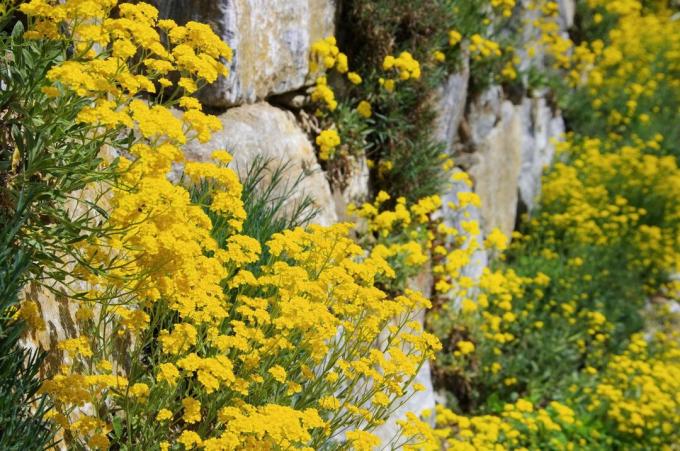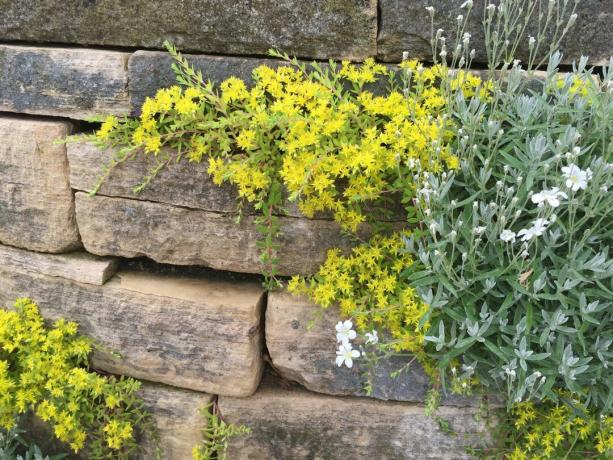A dry stone wall in the garden is not only decorative, but also provides an important habitat for beneficial insects. Here you can find out what you should consider when planting a dry stone wall.

Dry and natural stone walls have a long tradition in garden design: they used to be especially for delimiting cattle pastures, for terracing or for stabilizing a slope deployed. Today, on the other hand, they are a popular design element in horticulture. But the plants are not only visually appealing. Did you know that natural stone walls are also of great ecological importance? With the right planting, the dry stone wall not only turns into a real eye-catcher, but also offers a suitable habitat for numerous beneficial insects. We give you five tips on how you too can create an impressive dry stone wall in your garden.
contents
- What is a dry wall?
-
Plant dry wall: Our 5 tips
- 1. Suitable plants for the dry wall
- 2. Prepare drywall
- 3. Procedure for planting a dry wall
- 4. Maintain dry wall planting
- 5. Dry wall as habitat
What is a dry wall?
A dry stone wall is a garden element for visual structuring or delimitation of the garden area or for fixing slopes. Natural stone is the main building material used because of its visual appeal. Therefore, the term "natural stone wall" is often used synonymously with the term "dry wall". The difference to the conventional garden wall is not in the material, but in the construction of the dry stone wall. In this case, the layered stones are neither grouted nor otherwise bonded. The open joints of the natural stone wall can therefore be equipped with suitable plants, so that the wall is a frequently used design element in the garden.

Plant dry wall: Our 5 tips
1. Suitable plants for the dry wall
If you want to plant your dry stone wall, you will quickly find that not all plants are suitable for this. In fact, only plants that are hardy, drought tolerant and extremely robust come into consideration. Particularly succulents like stonecrop (sedum) and houseleek (sempervivum) are therefore ideal for planting in a natural stone wall. But not all dry stone walls are the same: While free-standing dry stone walls often dry out quickly, those that are in contact with the ground (e.g. to stabilize a slope) are significantly wetter. That is why they can also be taken from the cushion bellflower (Campanula portenschlagiana) or even small fern species. Blue cushions (Aubrieta), carpet phlox (Phlox subulata) and speedwell (Veronica) very good. Here you can even taste Mediterranean herbs rosemary (Rosmarinusofficinalis) or thyme (thymus) that actually benefit from the warmth that the heated stones give off at night. In shady areas one should on the other hand Corydalis (Corydalis), Waldsteinia (Waldsteinia) or cymbal (Cymbalaria muralis) set.

But the height also plays a role: only robust varieties like the mountain alyssum (Alyssum montanum) that can deal with drought and temperature fluctuations. In the base area, on the other hand, it is important that the plants are sturdy and flat-growing, such as star moss (Mnium ornum) is.
2. Prepare drywall
If you want to plant your dry stone wall, you should pay attention to a few things during construction. Ideally, the plants should be used when the wall is being built, as experience has shown that they grow and thrive better that way. Some nutrient-poor soil is filled between the joints and the plants are placed in their new location. Nutrient-rich soil or humus, on the other hand, are not suitable for the dry stone wall, since most plants for the rock garden have a low nutrient requirement. If you want to plant your dry stone wall later, you should make sure that there is enough space left for the plants when the stones are stacked. Joints that are about two fingers wide are recommended.
3. Procedure for planting a dry wall
The right time to plant a dry stone wall is between March and September. However, spring is considered to be particularly suitable, as the plants are just beginning their growing season. If you want to plant the natural stone wall afterwards, you should first fill the joints of the dry stone wall up to half with a permeable and nutrient-poor substrate. Soil that is too heavy or rich in nutrients is not suitable, since most plants for a dry wall are sensitive to waterlogging and too high nutrient concentrations. The suitable substrate is to be filled loosely in the joints, this works particularly well with a small shovel or a spoon.

Now you can start planting: Insert the plants horizontally with the root ball as deep as possible into the joint so that they have a good hold. Fill in the vacancies with substrate. With larger plants, it may be necessary to divide the perennial beforehand so that it can easily fit into the joints. It is best to use a sharp knife for this.
4. Maintain dry wall planting
After planting the dry stone wall, the plants must be watered well once. A garden hose with a hard water jet is the wrong choice here - the risk that the water will wash the soil out of the joints is too great. Instead, you should work with a watering can or a garden sprayer to be as gentle as possible. In the first two years, the dry stone wall should be watered from time to time so that the plants can establish themselves well. After that, the dry stone wall usually needs no more care. In fact, most drywall plants do best when left alone. A watering can with water may only be needed in particularly dry times - otherwise you hardly need to pay any attention to the natural stone wall.

5. Dry wall as habitat
Even if it is hard to believe: the natural stone wall is an important habitat for all kinds of animals. Insects are particularly fond of the dry stone walls. Many wild bee species, but also bumblebees and wasps use the free cracks as a shelter. At the same time, the dry stone wall also offers them a good supply of food with insect-friendly planting. If you want to give the beneficial insects a little more help, you can create a bed with insect-friendly plants in the immediate vicinity of the dry stone wall. Mixed seed like that Plantura bee pasture or the Plantura beneficial insect magnet have the advantage that they offer an even supply of food throughout the year due to their variety of plants. But not only insects are happy about the dry stone wall - common and green toads like to use larger gaps as hiding places. For the sand lizard, which has become rare, the dry stone wall is one of the most important survival areas. You can even see birds nesting in old natural stone walls with particularly large gaps.

Plantura bee pasture
Over 20 annual & perennial species for
Bees, bumblebees & co, easier to care for
Blossom dream in bed, pot & window box
Do you want to turn your garden into a paradise for bees? we have 10 bee friendly trees listed for you, which provide insects with a good source of food throughout the garden year.
...and receive concentrated plant knowledge and inspiration directly in your e-mail inbox every Sunday!



